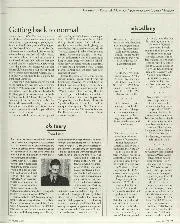
obituary-Tom Lush
Tom Lush, my closest friend, with whom I shared many motoring adventures, especially with A7s before the war, has died aged 84, after a long illness. Born in Peterborough, he…

Ground-effect racing car aerodynamics can be a double-edged sword. In essence, those airflow-accelerating underfloor surfaces were developed to suck the car’s chassis down against the road surface at high speed, therefore enhancing adhesion, traction and cornering grip. The technology has worked incredibly well when the constructor gets his sums and his shapes – and his car balance – right.
Back in 1978-79 at Ketteringham Hall – the home base of Team Lotus – I was shown a Lotus 79 in assembly. As the boys offered up a sidepod, engineer Nigel Bennett remarked “The question is, will it suck?” In practice the answer was absolutely ‘Yes’, it sucked alright, and driver Mario Andretti rhapsodised about how the car “…feels like it’s painted onto the road…”
Now that’s fine, as long as the road surface itself stays put, and bits of it don’t get sucked up towards the car’s underfloor, as opposed to the underfloor getting sucked down towards the road. And so we arrive at what can happen when a piece of road surface, aka a loose drain or manhole cover, is potentially detachable.
If such covers have not been tagged, bolted or welded in place they can obviously pose a truly sinister hazard. The first time I really appreciated this was when a friend returned from a 1960s Angolan GP in Luanda, describing how his practice laps had been punctuated by finding “…blokes on their hands and knees in the middle of the track, welding manhole covers shut.”
In more recent times, loose covers of this kind have caused disruption at such circuits as Monaco and Shanghai. So when I saw the unfortunate George Russell’s Williams FW42 being eviscerated by an up-edged cover during GP practice at Baku, my instant reaction was twofold: A) Cor! – I hope that missed the poor kid’s nethers! – and B) Oh my, here we go again…
Obviously an insecure drain cover can be flicked up by the bounce of contact from a wheel, but the sheer suction effect of a modern racing car’s underfloor – despite being only fleetingly applied – can still be truly immense.
Another friend once told me how he’d recently tested a Nissan IMSA prototype. It had the most enormous underfloor area, generating more downforce than he’d ever, at that time, experienced. But what really impressed was more the in-cockpit noise the thing generated.
“I did a slow first lap or two just to find where everything was…” he recalled, “… then went for a time. The turbocharged engine was relatively quiet but the faster I went, this weird roaring, rumbling background noise built up. Even with earplugs it became almost deafening. I felt sure it must be coming from the transmission or a spun wheel bearing. So I pulled into the pits and reported this terrible noise. And they just looked at me, then burst out laughing and said ‘Oh that’s just the airflow through the underfloor tunnels. Haven’t you heard that before?”
So then I thought back to September, 1990, and the Mondial Players race – the penultimate round of that year’s FIA Sports Prototype World Championship series – on Montréal’s Île Notre Dame Circuit, or Circuit Gilles Villeneuve. That race was notable for two things – the racing debut of the new 3.5-litre V10 Peugeot 905, and for being stopped by the most catastrophic ‘manhole’ incident seen yet.
“The shattered cover blasted through the Porsche’s windscreen”
Kenny Acheson’s Lola-Nissan R90CK first dislodged an insecure manhole cover on the very fast backstretch. It thudded against his car’s undertray, then skated back into the path of Fermín Vélez’s Spice SE90C, which also clipped it but continued. French driver Denis Morin’s Courage-Porsche C24S was next along, and he hit the tumbling cover hard. The Courage vaulted over it and slithered to rest with its front end and underside completely shattered…
Husky Spaniard Jesús Pareja was right behind, flat-strap in the Brun team’s Porsche 962C which he was sharing with Swiss Bernard Santal. Part of the shattered, now bouncing, cover blasted straight through the Pareja car’s windscreen – miraculously missing him somehow – but other debris ‘did a Russell’ to the turbocharged Porsche’s underside, slitting its monocoque and puncturing the midships fuel tank.
Spilled fuel instantly ignited into a furious fire, and the Pareja Porsche pin-wheeled along the retaining wall.
In his wheel tracks was his Norwegian team-mate Harald Huysman, who in avoidance crashed the second Brun Porsche 962C into the wall. Pareja then managed to escape unaided from that glittering fireball, but – understandably rather peeved after the incident – he then had an altercation with marshals whose arrival and warnings he clearly deemed inadequate.
The race was red-flagged, not re-started, and the result was declared as at the end of lap 61, so only half championship points were awarded.
That was a multi-million dollar ‘manhole cover’ crash – and it was also, reputedly, the first race in which Jesús Pareja had worn a full-face helmet. Now there – like George Russell – was a rather lucky boy.
Doug Nye is the UK’s leading motor racing historian and has been writing authoritatively about the sport since the 1960s